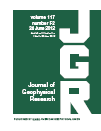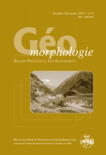
ZEITSCHRIFT FUR GEOMORPHOLOGIE
Scope & Guideline
Pioneering Research in Earth-Surface Evolution.
Introduction
Aims and Scopes
- Geoarchaeology:
The journal emphasizes the integration of geomorphology and archaeology, focusing on how landforms and sedimentary processes influence archaeological contexts and human history. - Landslide and Hazard Assessments:
A significant area of focus is the assessment of landslide hazards, particularly in tectonically active regions, employing methodologies such as GIS and AHP to evaluate risk and inform management. - Coastal and Riverine Dynamics:
Research on coastal geomorphology and sediment dynamics in riverine environments is prevalent, with studies analyzing sediment transport, beach morphodynamics, and the impacts of hydrotechnical works. - Climate Change Impacts:
The journal publishes studies that assess the geomorphological effects of climate change, particularly in coastal and mountainous regions, highlighting the sensitivity of landscapes to climatic variations. - Palaeoenvironmental Studies:
There is a strong emphasis on reconstructing past landscapes and environmental conditions through various methods, including sedimentology and geomorphometry, to understand geomorphic evolution.
Trending and Emerging
- Integration of Geospatial Technologies:
There is a marked increase in studies utilizing GIS and remote sensing technologies for geomorphological analysis, emphasizing their role in modern landscape assessments and hazard evaluations. - Impact of Climate Variability:
Research focusing on the impacts of climate change and variability on geomorphological processes has gained prominence, highlighting the need to understand and mitigate the effects of climate on landscapes. - Geoarchaeological Investigations:
The trend towards geoarchaeological studies is rising, as researchers increasingly explore the interplay between human activity and geomorphological changes, offering insights into past civilizations and their environments. - Sediment Dynamics and Management:
Emerging themes include the study of sediment dynamics, particularly in coastal and riverine contexts, reflecting an increased focus on managing sediment transport and its implications for ecosystems and human activities.
Declining or Waning
- Traditional Fluvial Processes:
Research focused solely on traditional fluvial processes, such as river morphology without the integration of contemporary geomorphic and environmental challenges, appears to be less prevalent. - Purely Descriptive Geomorphology:
There seems to be a decline in purely descriptive studies that lack a strong methodological framework or application, as the journal increasingly favors interdisciplinary and applied research. - Geological Mapping without Modern Techniques:
Studies that rely solely on conventional geological mapping techniques without incorporating modern technologies such as GIS, remote sensing, or geophysical methods are becoming less common.
Similar Journals

E&G Quaternary Science Journal
Connecting Humanity with Earth’s EvolutionE&G Quaternary Science Journal, published by COPERNICUS GESELLSCHAFT MBH in Germany, stands as a prominent open-access platform dedicated to disseminating high-quality research in the fields of archaeology, geology, paleontology, and stratigraphy since its inception in 1979. With its ISSN 0424-7116 and E-ISSN 2199-9090, the journal has achieved remarkable recognition, indicated by its Q1 quartile ranking in archaeology across both arts and humanities sections, and its strong placements within the social sciences and Earth sciences categories. The journal provides crucial insights into the Quaternary period, contributing to our understanding of climate change, human evolution, and geological processes, making it invaluable for researchers, professionals, and students engaged in these collaborating disciplines. As an open-access journal since 2008, it ensures that cutting-edge research is readily available to a global audience, promoting knowledge exchange and facilitating advancements within the scientific community. The continuous commitment to excellence and its strategic focus on high-impact research positions E&G Quaternary Science Journal as a cornerstone publication in quaternary science.

Earth Surface Dynamics
Transforming Understanding of Terrestrial EnvironmentsEarth Surface Dynamics, published by COPERNICUS GESELLSCHAFT MBH, is a pioneering open-access journal dedicated to the study of geophysical processes and Earth-surface dynamics. Since its inception in 2013, this journal has established itself as a vital platform for disseminating high-quality research in the fields of Earth-Surface Processes and Geophysics, earning a prestigious Q1 ranking in both categories as of 2023. With an impressive Scopus ranking of #33 out of 179 for Earth-Surface Processes and #31 out of 165 for Geophysics, it captures the attention of leading researchers and professionals in the Earth sciences community. The journal is committed to providing a forum for innovative and interdisciplinary research that enhances our understanding of terrestrial environments and their dynamics, making it an essential resource for students, academics, and industry professionals alike. Please visit our journal to explore groundbreaking research and contribute to the ongoing dialogue in the dynamic field of Earth science.

JOURNAL OF SEDIMENTARY RESEARCH
Shaping the Future of Sedimentary ResearchThe JOURNAL OF SEDIMENTARY RESEARCH, published by SEPM-SOCIETY FOR SEDIMENTARY GEOLOGY, stands as a pivotal peer-reviewed journal in the field of sedimentary geology. With an ISSN of 1527-1404 and an E-ISSN of 1938-3681, this esteemed journal features a broad scope, delving into the intricacies of sedimentary processes, lithology, and stratigraphy since its inception in 1931. Enjoying a distinguished reputation, it has achieved a Q1 category ranking in Geology for 2023 and ranks 87 out of 321 in Earth and Planetary Sciences, placing it in the 73rd percentile among its peers in Scopus. With continued access options available, it facilitates the dissemination and discussion of cutting-edge research that shapes the understanding of sedimentary phenomena. Researchers, professionals, and students alike benefit from this critical platform that fosters academic engagement and drives progress within the field.

JOURNAL OF GEOPHYSICAL RESEARCH-EARTH SURFACE
Pioneering Research on Earth's Surface Interactions.JOURNAL OF GEOPHYSICAL RESEARCH-EARTH SURFACE, published by the American Geophysical Union, stands as a leading voice in the fields of Earth-Surface Processes and Geophysics. With an impressive impact factor placing it in the Q1 category for both disciplines, this journal offers invaluable insights and research findings that address critical challenges related to Earth's surface dynamics and processes. Since its inception in 2004, the journal has been dedicated to fostering a deeper understanding and interdisciplinary exploration of topics critical to environmental science, geology, and geophysics. Researchers and professionals in the field will find cutting-edge studies meticulously peer-reviewed to ensure high quality and relevance, making it an essential resource for academics, practitioners, and students alike. The journal's significant Scopus rankings — 25th out of 179 in Earth-Surface Processes and 26th out of 165 in Geophysics — underscore its influence and the rigor of its content, encouraging submission and engagement from leading scholars globally.

GEO-MARINE LETTERS
Unveiling the Secrets of Earth’s Marine EcosystemsGEO-MARINE LETTERS, published by Springer, is a prestigious academic journal that has been a pivotal platform for the dissemination of innovative research in the fields of Earth and Planetary Sciences, Oceanography, Environmental Science, and Geotechnical Engineering since its inception in 1981. With an E-ISSN of 1432-1157, this journal has established itself in the Q2 quartile across multiple categories in 2023, indicating its influential position within the scientific community, as reflected by its Scopus rankings. While it currently does not offer an open access option, its rigorous peer-review process ensures the publication of high-quality research that contributes significantly to advancing our understanding of marine and geological sciences. Researchers, professionals, and students alike will benefit from the diverse scope of studies featured in GEO-MARINE LETTERS, making it an essential resource for those engaged in environmental and marine research. Situated in Germany, the journal's commitment to excellence continues to shape critical discussions and innovations in the field.

SEDIMENTOLOGY
Navigating the intricate world of sedimentary studies.SEDIMENTOLOGY (ISSN: 0037-0746, E-ISSN: 1365-3091) is a premier journal published by Wiley in the United Kingdom, dedicated to advancing the scientific understanding of sedimentary processes, depositional environments, and the broader implications for stratigraphy and geology. With an impressive impact factor that places it in the prestigious Q1 category within both geology and stratigraphy, SEDIMENTOLOGY ranks among the top journals in its field, with Scopus rankings of #3 in Stratigraphy and #20 in Geology, reflecting its significant influence and the high-quality research it publishes. This journal, which conceives high-impact research contributions from 1962 to 2024, serves as an essential resource for researchers, professionals, and students alike, fostering a deeper exploration of sedimentary systems and providing a forum for the dissemination of novel findings. Although not open access, articles published in SEDIMENTOLOGY are critical for enhancing our understanding of sedimentation dynamics, which have far-reaching implications for natural resource management and environmental assessments.

Frontiers of Earth Science
Connecting Researchers to the Frontiers of DiscoveryFrontiers of Earth Science is a prominent academic journal in the field of Earth and Planetary Sciences, published by Springer. With an ISSN of 2095-0195 and an E-ISSN of 2095-0209, this journal serves as a significant platform for researchers and professionals to disseminate their findings from 2007 to 2024. It is recognized for its impactful contributions within the category of Earth and Planetary Sciences, boasting a respected Q2 ranking in 2023. With a Scopus ranking of 64 out of 195, placing it in the 67th percentile, Frontiers of Earth Science continues to drive academic dialogue and innovation. The journal is dedicated to exploring a diverse range of topics, including geology, meteorology, and environmental science, and amplifying the understanding of Earth systems through rigorous research. Located in New York, USA, this journal embraces an Open Access model, ensuring that groundbreaking research is readily available to the global scientific community, thereby enhancing its accessibility and impact.

Geographia Polonica
Connecting Cultures and Spaces in Academic DiscourseGeographia Polonica is a premier academic journal published by the Polish Academy of Sciences, Institute of Geography and Spatial Organization, renowned for its contributions to the field of geography and related disciplines. With a history spanning from 1972, it has evolved into a vital resource for researchers and professionals, addressing a wide spectrum of topics from cultural studies to urban planning and development. Geographia Polonica is indexed with impressive rankings in various categories, including a Q1 classification in Cultural Studies and significant positions in Earth and Planetary Sciences and Urban Studies, reflecting its influence and recognition in these critical areas. Although it operates under a traditional subscription model, its commitment to high-quality, peer-reviewed research ensures that the latest findings and advancements are accessible to the academic community. With its rich archival content and contemporary insights, Geographia Polonica serves as an essential platform for scholarly dialogue, making it an invaluable reference for students, researchers, and professionals eager to explore the complexities of spatial organization and geographical phenomena in a global context.

Geomorphologie-Relief Processus Environnement
Illuminating the Interplay of Relief and EnvironmentGeomorphologie-Relief Processus Environnement is a pivotal journal in the field of Earth-Surface Processes, published by the GROUPE FRANCIAS GEOMORPHOLOGIE in France. With an ISSN of 1266-5304 and E-ISSN 1957-777X, the journal has established a notable presence since its inception in 1995. Though it operates without Open Access, it remains an essential resource, particularly in the niche area of geomorphology where it offers valuable insights into the interactions between relief features and environmental processes. The journal achieved a Q3 ranking in 2023 among Earth-Surface Processes, attesting to its significance in advancing research and discussions within this discipline, while it ranks #113/179 in Scopus, placing it in the 37th percentile. By fostering interdisciplinary dialogue and disseminating high-quality research, Geomorphologie-Relief Processus Environnement serves as a vital platform for researchers, professionals, and students eager to explore the complexities of our planet's surface processes.

Journal of Sedimentary Environments
Connecting Researchers to Shape the Future of Sedimentary Studies.Journal of Sedimentary Environments is a leading open-access publication dedicated to advancing the study of sedimentary processes and environments. Published by SPRINGER HEIDELBERG, this journal embraces a wide array of topics including sedimentology, paleoenvironments, and the interactions between sediments and ecosystems. Since its transition to open access in 2016, it has prioritized making high-quality research widely available, fostering collaboration and innovation among researchers, professionals, and students in the field. With a commitment to excellence, the journal aims to publish groundbreaking studies that enhance our understanding of sedimentary environments, making it an essential resource for anyone interested in the dynamics of Earth’s sedimentary systems. Located in Heidelberg, Germany, this journal is poised to play a vital role in shaping current and future research discussions worldwide.